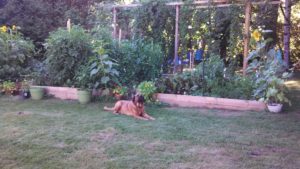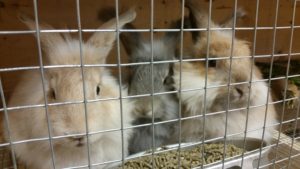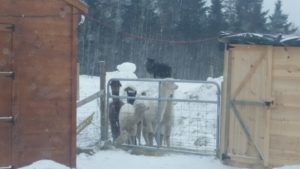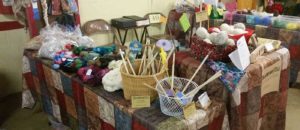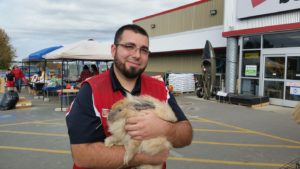Gallifreyan Farm is a small start-up farm in Northern Maine that focuses on alternative and sustainable agriculture and fiber.
Vegetables
Our dream started many years ago as we sought for more efficient and effective vegetable production on a quarter-acre lot in our quiet Houlton neighborhood. We quickly realized that we were able to produce enough vegetables for us, and most of our non-farming family, utilizing just over 200 square feet of garden. While there are lots of neat-o whiz-bang chemicals out there that might help produce higher crop yields, they also cost a lot money, and sprinkling nuclear green mystery stuff on our gardens just didn’t sit well with us.
We reached out to a farmer friend, who was thrilled to provide us with all the truckloads of aged cow manure that we could ever want. Sure, it smelled a little funny around here for awhile, but our plants exploded with growth and vegetable production. As we sat on the back deck one evening, we pondered: “Exactly what are we going to do with all that food?” A momentary panic set in, since we didn’t really have any sort of plan in place for harvest storage. But we managed.
The fun part about the backyard garden, is that the entire thing was just one huge experiment. Some of it paid off, some of it didn’t. But seeds are relatively inexpensive, and it was an overall fun hobby to keep us off the internet during the summer months.
Fiber
With two “grandmonkeys” in the family, and a growing number of local friends who participate in 4H, we had some long discussions about how we could get the grandmonkeys interested in 4H, and learning about animals and gardening and how everything in the world around us has its place and purpose. We did some digging around and discovered that most kids were showing rabbits and alpacas, and even joked about keeping a couple alpacas at the house.
Our research into rabbits introduced us to angora rabbits. Not only are these beautiful animals, but their fur is used for spinning yarn. We drilled deeper into the world of angora rabbits to discover what is considered the best fiber breed out there: German angora. We found a breeder downstate (who is since retired), and on our way there, we found the French/English angora boys, who have been a staple on our farm’s promotional material.
Soon we added Roger and Molly, our first German angoras, then came Snow Shoe, Miss Attitude, and Cedar, then Robin and Anna Marie (French angoras), then.. then.. then..
So it turns out that rabbits multiply quickly, even if they aren’t bred!
We are fortunate to have a yarn mill right here in The Country: Aroostook Fiberworks. Andy has been a fantastic guy to deal with, and one day, while we were picking up the latest yarn order, he asked us: “Did you guys have any interest in some alpacas? I will make you a hell of a deal…” We were, and he did, and talk about a “trial by fire”; we were pretty clueless going in with alpacas, but it’s been quite some time, and they are thriving, and we really couldn’t be happier. More recently, we added a male cria from RMT Farms, who will be a fine fine flock stud, when we let him, and then had a trio of gorgeous Icelandic sheep somewhat fall into our laps from Kilby Ridge Farm.
So, yes, we do have sheep. And alpacas. And angora rabbits.
Fun fact: Angora wool comes from angora rabbits, but mohair comes from angora goats. Why is that? Because goats have “mo’ hair” than rabbits!
Eggs
What’s a farm without a few chickens? To be fair, a lot of people also point out: “What’s a farm without a few cows?” but we’re not going to go there; nor are we going to get any cows.
Way back during the “backyard days”, we decided to get a half a dozen chickens for eggs for “personal use”. Our manure-sharing farmer friend also helped us out with the chickens, and wound up giving us, honestly, way more chickens than we had space for. Un/Fortunately, several turned out to be roosters, so they had to go back home after a visit from Animal Control. Who would have thought a silkie rooster could crow THAT loud?
Video proof on the left. This was actually taken from the neighbor’s Facebook page.
Since then, however, we now have a fully-loaded coop of ISA Browns and Leghorns, and even two of our original silkies.
Oddly enough, though, we managed to avoid any roosters this go-round, but have started providing both white and brown eggs to several local customers, as well as Trailside Country Store in beautiful Millinocket.
Events
Few farms do as many events in a year as we do.
It all started with a week’s notice that we’d been accepted at the Houlton Craft Fair one year. Boy, did we scramble to get prepared for that! While we had some of our Merino/Angora yarn available, that was about it. We had some bits of dyed roving that we’d outsourced then hand-dyed, and some felting tools, but it really threw us for a loop because we were in no way prepared for such a big event. Oh! We did have wool dryer balls, and sold nearly an equal amount as dryers balls as we did as cat toys. For those of you who met us for the first time at that craft fair, you were a first-hand witness as to the power of determination blended with a healthy dose of fear and panic.
After the two brutally long days of completely flying by the seat of our pants, we were done as quickly as we’d started. We survived! We sold out of dryer balls (cat toys), and were lighter a lot of skeins of yarn and hand-dyed roving. One of us even stabbed himself while learning how to needlefelt (pro-tip: Those needles are barbed. Avoid stabbing yourself, because it really hurts.) We were elated, because we felt that the Farm had an excellent showing, and we learned a lot on running a booth.
Over our first summer, we were mainstays at the Houlton Community Market in Market Square, as well as Tractor Supply. We made a lot of friends in both places, especially when we’d bring a rabbit or two to show off. Some weekends, there were conflicting events, so we’d divide and conquer and do both of the events.
Being invited to the Southern Aroostook Rural Living Days was always a goal of ours, but we weren’t expecting it to happen during our first year of operation. We took Robin and Remy’s litter of juvenile rabbits for show n’ tell (and for sale), as well as Miss Attitude so that we could do a shearing demonstration. Being accepted into the Millinocket Marathon and a Half Artisan Fair was mind-boggling. And so many more smaller events, and we loved them all, big and small.
Because we don’t get to enough of other events, the Farm is hosting several now, to include the Southern Aroostook Fiber Artists group, as well as the Li’l Growers program.
We will continue to grow and expand, and it’s all thanks to you.


